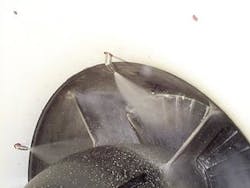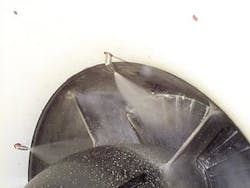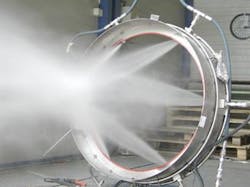High pressure spray technique operable with full or part-loads
Gas Turbine Efficiency is developing tech-nology that will allow offshore platforms to wash their gas turbines on full or reduced load.
Gas turbines take in so much air in the salty offshore environment that they may have to be washed daily.
null
The intake of all that air, which is not always clean, can make the turbines dirty, rendering them less efficient. Salt in the air can stick to the rotors and blades, constricting the gas path for each turbine.
"This salt builds up a layer in the gas path, which causes an aerodynamic degradation," Hjerpe said.
The salt deposits contaminate the gas path components, causing a reduction in pressurization of the gas compressor.
Cleaning the gas turbines reduces carbon dioxide by countering degradation in the gas turbine, thereby saving fuel. As GTE points out, clean engines significantly reduce CO2 emissions. For example, combustion of 1 kg of natural gas results in 2.75 kg of CO2 being emitted. The LM 2500 gas turbine, which consumes at full load 1.35 kg/sec of gas, in turn generates 3.54 kg/sec of CO2 emissions. Each percentage point of efficiency loss in the LM2500 engine increases fuel consumption by 150 kg/hr, according to GTE, resulting in emissions of 400 kg/hr of CO2.
Cleaning up
The optimum cleaning method, Hjerpe said, is to ensure liquid sprays at a high pressure. If the droplets are too big, the centrifugal effect throws the droplets to the periphery. GTE's system employs atomized droplets at a certain size, spray density, and velocity, and loses liquid to the periphery.
Some machines do exceptionally well with online cleaning, and GTE is working to perfect the technique with all gas turbines. "We're studying how these droplets behave when they enter the compressor for all configurations," Hjerpe said.
GTE's technique places the nozzles upstream of the compressor inlet in a permanently-installed configuration around the air intake of the engine. Placing the nozzles closer to the intake means the dirt, mostly in the front end of the compressor, is the first target, Hjerpe said. The units tend to be cleaner further back.
The nozzles inject water in the gas path to dissolve the deposits. Fluid released at a higher pressure means fewer nozzles are needed to release the correct amount of atomized water droplets. Droplet size is also important in considering impact force against compressor blades, especially during online washing.
null
Hjerpe said the company has been very successful with water-only online cleaning, which is less expensive for clients because they don't need to buy cleaning fluid. Also, the system leads to less spillage due to its more efficient hit-rate. Furthermore, the concept brings cost savings in capital expenditure as the same nozzle system is used for both on- and offline washing.
The low-pressure approach used by other companies requires a large number of small capacity nozzles is more costly, takes up more space, and has increased risk of nozzle blockage, GTE claims.
GTE says its cleaning system has improved online pure water cleaning, does not leave detrimental wear on coatings, completes the gas path penetration in a short time, does not stain rotating or other components, and saves resources.
Among the spin-offs are less hazardous online cleaning, reduced "fast cool down" problem, elimination of hazardous chemicals, and less waste to dispose. The units are designed for new or retrofit use on every type of gas turbine, installation, or application.
GTE has recently received cleaning system orders for the Statoil Gullfaks and Statfjord platforms.
For more information, contact Carl-Johan Hjerpe, Gas Turbine Efficiency. Tel: +46 8 760 85 50, fax: +46 8 760 86 50, [email protected], www.gte.se.


